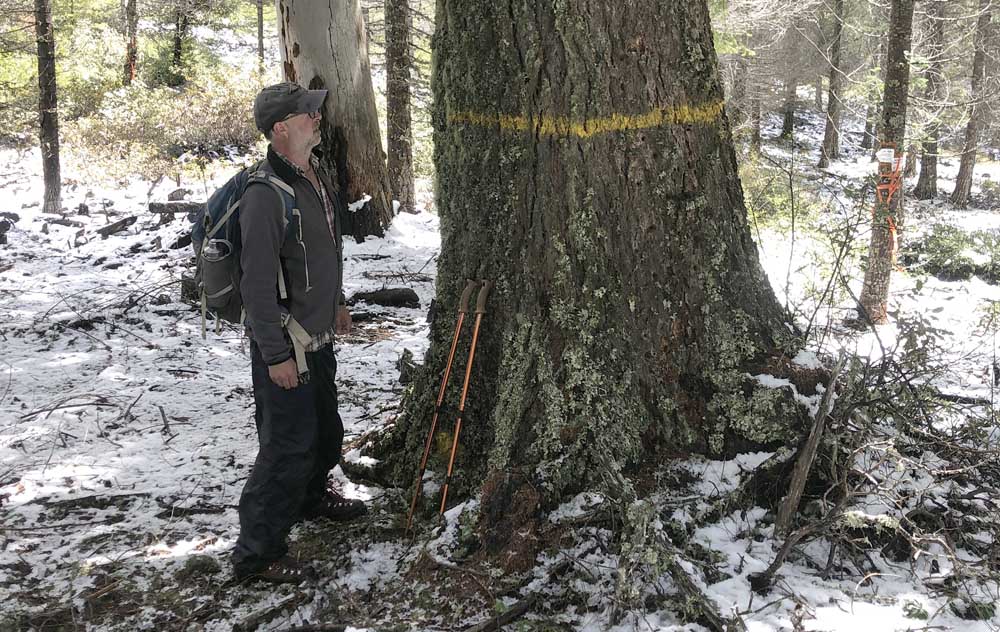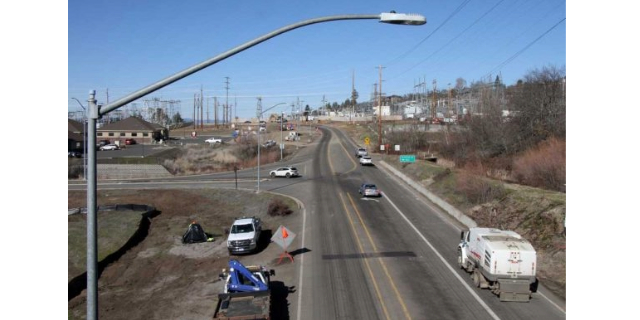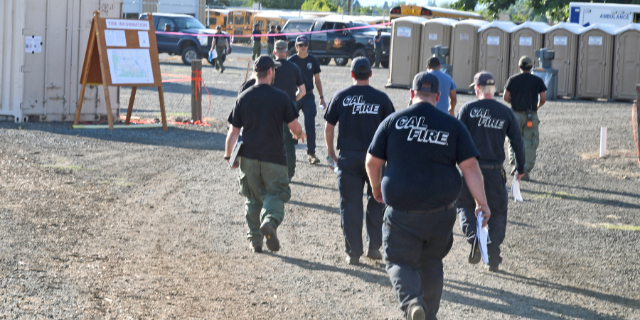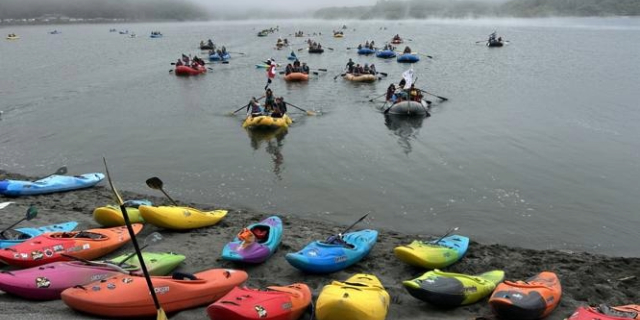Conservation groups, BLM ask judge to rule on old-growth timber sales
Published 2:45 pm Tuesday, January 30, 2024

- George Sexton, conservation director at the Klamath-Siskiyou Wildlands Center in Ashland, stands next to a tree he said was originally marked to be saved as a wildlife tree, but later slated to be logged to make way for a road as part of the Late Mungers project near Williams. The project, proposed by the U.S. Bureau of Land Management, is an effort to reduce wildfire danger and improve forest health, but a federal judge last week ruled against the agency's plan to log large trees in protected reserves.
As the clock ticks, lawyers are arguing the merits of a government program intended to speed logging in the name of wildfire risk reduction and forest health on certain federal forestland in southwest Oregon.
Trending
Lawyers on both sides in the nearly year-old case of Klamath-Siskiyou Wildlands Center, et al., vs. the U.S. Bureau of Land Management have filed motions asking a federal judge in Medford to rule without the need to go to trial.
The case, which involves BLM’s intention to log about 800 acres of large trees near Williams, is a test of the agency’s 2-year-old Integrated Vegetation Management for Resilient Lands Program, which uses an already completed area-wide environmental assessment so one won’t be needed later when the agency wants to log, thin and conduct prescribed burns under certain conditions. The program as designed would allow up to 20,000 acres of commercial logging, 60,000 acres of thinning and 70,000 acres of prescribed fire projects over 10 years on BLM-managed forestland that stretches across much of Josephine and Jackson counties.
Lead plaintiff KS Wild and co-plaintiffs Cascadia Wildlands, Oregon Wild and Soda Mountain Wilderness Council sued the BLM last spring in U.S. District Court and filed for summary judgment — a ruling without trial — in November. The BLM filed its own motion on Friday for summary judgment, stating that its logging plans were intended to “improve habitats, decrease catastrophic fire risk, and improve landscape resilience.”
Trending
Lawyers are due to argue the case in person on April 2 in Medford before Magistrate Judge Mark D. Clarke. The hearing comes in advance of an April 25 auction set by the BLM to sell logging rights to timber on the 800 acres. The auction had been planned for last Thursday, but the BLM last week delayed it so the auction could take place closer to the start of timber harvest season, May 15. The timber to be sold is in two allotments known as the Late Mungers and Penn Butte sales.
The BLM proposes to log trees up to 36 inches in diameter, although larger trees could be felled for safety or road-building purposes and left on the property. KS Wild and the other plaintiffs say they only want to stop the logging of the bigger trees, in order to protect habitat of the threatened northern spotted owl.
“Plaintiffs respectfully ask this Court to grant narrowly tailored relief targeted at the commercial components,” they state in their filing for summary judgment.
However, the BLM has linked the logging of those 800 acres to fuels reduction work on 7,500 nearby acres, where the thinning of small trees under 8 inches in diameter and prescribed burning would take place. The filing of the lawsuit halted the entire project, known as the Late Mungers project, including logging, thinning and prescribed burning.
“We can’t move forward with anything because it’s under litigation,” BLM spokesman Kyle Sullivan said after the lawsuit was first filed.
The Late Mungers project logging and fuels work, if and when it takes place, wouldn’t be done all in one swath, but would take place on more than 40 tracts in the mountains between Williams and Murphy. The proposed work focuses on ridgetops and near roads, including Spencer Creek Road, Powell Creek Road and Mungers Creek Road. Spencer, Powell and Mungers creeks are in drainages that flow into the Applegate River.
Both sides have notified Clarke that they tried but could not come to an agreement.
“Parties made a good faith effort to resolve the dispute but were unable to do so,” according to a filing by the plaintiffs.
KS Wild and the other plaintiffs argue that the BLM’s actions would threaten large blocks of land known as late-successional reserves that were set aside to protect the threatened northern spotted owls.
“The Bureau of Land Management takes a sledgehammer to the integrity of those reserves by proposing logging treatments that will decimate currently functioning owl habitat and, despite steep population declines, it will do so in areas occupied by reproductively successful and demographically important owls,” according to the lawsuit. “Under the guise of managing for wildfire, the (program) authorizes heavy logging that not only violates BLM’s own land management plan and the very provisions intended to protect the reserves, but also violates (the National Environmental Protection Act).”
The BLM, however, contends that the program is consistent with the agency’s adopted resource management plan and that it complies with federal environmental law. In its filing, the BLM states that it took a “hard look” at the program’s effects on the environment, including its effects on the owl and fire resistance.
The agency’s finding that the program would cause no significant impact to the environment “is fully supported by the record and was not arbitrary or capricious,” BLM attorney Alexis G. Romero of the U.S. Justice Department stated in the filing.
The stakes in the case are high, with wildfire risk in the region increasing over time due to drought, disease, insects, densely packed second-growth trees and decades of fire suppression that has left brush and forest fuels intact to burn.
George Sexton, KS Wild’s conservation director, referring to logging strategies outlined in the program that create open spaces, vowed to protect old growth forests.
“KS Wild and our allies will continue to press ahead with our litigation to protect these old-growth forests from ‘gap-creation’ mini-clearcuts and ‘open seral’ logging prescriptions that would remove late-successional forest canopy,” Sexton said in a written statement last week. “We will also continue to advocate for small-diameter fuels treatments and prescribed fire that retains, rather than removes late-successional forests.”
Doug Robertson, president of the Association of O&C Counties, said in a court filing in support of the BLM’s position that the agency’s vegetation program and the Late Mungers project would help decrease fire danger, provide jobs, fund schools and provide lumber for housing.
“These projects are intended, and will, decrease wildfire risk in Southern Oregon,” Robertson wrote. “This is exceedingly important in Josephine and Jackson Counties … where catastrophic wildfires have destroyed thousands of homes.
“These projects will also bring job opportunities to these communities,” Robertson continued. “Federal timber harvest has significant beneficial downstream economic impacts, providing jobs for timber fallers, truckers, road construction, mill workers, and many more.”
A group in Williams, the Williams Community Forest Project, celebrated last week when the BLM put off the planned auction of the Late Mungers and Penn Butte timber sales.
“The BLM auction that was to occur on Thursday the 25th at the BLM office in Medford is off for now. Whew!!,” the group announced via social media. “Thank you to everyone who was planning on going to the BLM to protest the sale. You make a difference ….”
Details about BLM’s plans can be found online at bit.ly/48UNMju. Information from KS Wild can be found at kswild.org/press-releases/ivm.









